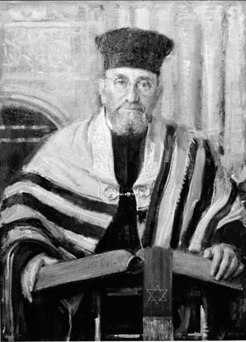The Israel Porush Collection
Rabbi Dr. Israel Porush O.B.E. was a highly respected and influential Orthodox Jewish leader who dedicated his life to promoting religious scholarship, interfaith dialogue, and the preservation of Jewish history in Australia.
Our library is proud to house a part of Porush’s private book collection. The collection was generously presented to the library by Mrs. Bertha Porush in memory of her devoted husband. The collection provides a valuable resource for scholars, researchers and those interested in Porush’s extensive range of interests.

Israel Porush, photo of painting by W. E. Pidgeon, 1961
National Archives of Australia, A1200, L40777
Rabbi Dr. Israel Porush O.B.E. (1907 – 1991)
Based on Suzanne D. Rutland’s article in the Australian Dictionary of Biography, Volume 19, 2021.
Rabbi Dr. Israel Porusch-Mandel was born on 16 July 1907 in Jerusalem, Palestine. The second of seven children of Eliyahu Porusch-Mandel, hospital manager, and his wife Deborah Gittel, née Makofki. Strict Orthodox Jews, Eliyahu’s family had arrived in Palestine in the first half of the nineteenth century from Eastern Europe, while Deborah came from a well-known rabbinic family.
Israel grew up in a deeply religious home, studying at the Etz Chaim Yeshiva until the age of fifteen. Wanting him to have a secular education, his father sent him to school in Germany in 1922. Matriculating in 1927, he studied mathematics and other secular subjects at the University of Berlin and rabbinics at the Hildesheimer Rabbinical Seminary also in Berlin. In 1931 he completed a doctoral thesis in algebra at the University of Marburg (PhD, 1933), and the following year was ordained.
Employed as a principal of a Talmud Torah, he lost his work permit in 1933 and, repulsed by the oppression of Jewish people under Hitler’s regime, decided to migrate to London. Rabbi Dr Isidore Epstein, principal of Jews’ College, employed him as a tutor and later commissioned him to translate two tractates for the Soncino Talmud. He enrolled in an English matriculation class at the London Polytechnic and with improved English skills accepted a job at Finchley Synagogue in 1934. The same year on 7 October he married Bertha.
In 1938 Porush refused the offer of a post at the Melbourne Hebrew Congregation. A year later, concerned at the gathering war clouds and hopeful that the role would enable him to deal with a broader range of religious and community matters, he accepted the position of senior rabbi at the Great Synagogue, Sydney.
Inducted on 6 June 1940, Porush served for nearly thirty-three years, becoming known as the ‘uncrowned chief rabbi of Australia’. The Commonwealth’s chief rabbi, Lord Jakobovits, described him as combining ‘rabbinical learning, general scholarship and exceptional leadership’. His years of service covered a watershed period in Australian Jewish history, due to the impact of the pre- and post-World War II European Jewish refugees and survivors. He was naturalised on 25 September 1941. Concerned at the influence of Nazi anti-Semitism, he founded the New South Wales Council of Christians and Jews in 1943.
A strong supporter of religious Zionism, he was a member of the Mizrachi movement. He served as head of the Sydney Beth Din from 1940 to 1975, and oversaw the congregation’s expansion and the opening of the War Memorial Centre in 1956. He established the Great Synagogue Youth, providing intellectual dialogue, but was also able to play table tennis with young people. Always there to provide wise counsel to congregants, he maintained an office to receive visitors at the synagogue and at home.
Porush organised the first conference of the Australian rabbinate in 1946, which eventually became the Association of Jewish Ministers of Australia and New Zealand in 1952. He served as its president until 1975, convening seven conferences.
Another of Porush’s passions was his people’s history in Australia. President of the Australian Jewish Historical Society (1948-74), he wrote a history of the Great Synagogue, The House of Israel (1977), as well as twenty-one articles for the AJHS Journal of Proceedings, over two hundred articles for the Great Synagogue Journal, and entries in the Encyclopaedia Judaica. Selected sermons were published as Today’s Challenge to Judaism in 1972, and his memoirs, The Journal of an Australian Rabbi, in 1992. From 1951 he lectured part time in the department of Semitic studies at the University of Sydney. Appointed OBE in 1966, he received the B’nai B’rith award in 1981.
Throughout his career Bertha was his constant companion. She assisted newcomers in both London and Sydney and worked for the women’s auxiliaries of the synagogue and the New South Wales Board of Jewish Education. After his retirement from the synagogue in 1973, the couple lived at Bondi, before settling in Melbourne in 1975, after he stepped down from the Beth Din. He died on 22 May 1991 at North Caulfield, survived by Bertha and one daughter; another daughter had died in 1969. He was buried at the Springvale Chevra Kadisha cemetery in Melbourne and was later reinterred at the Har Hamenuchot cemetery in Jerusalem.
